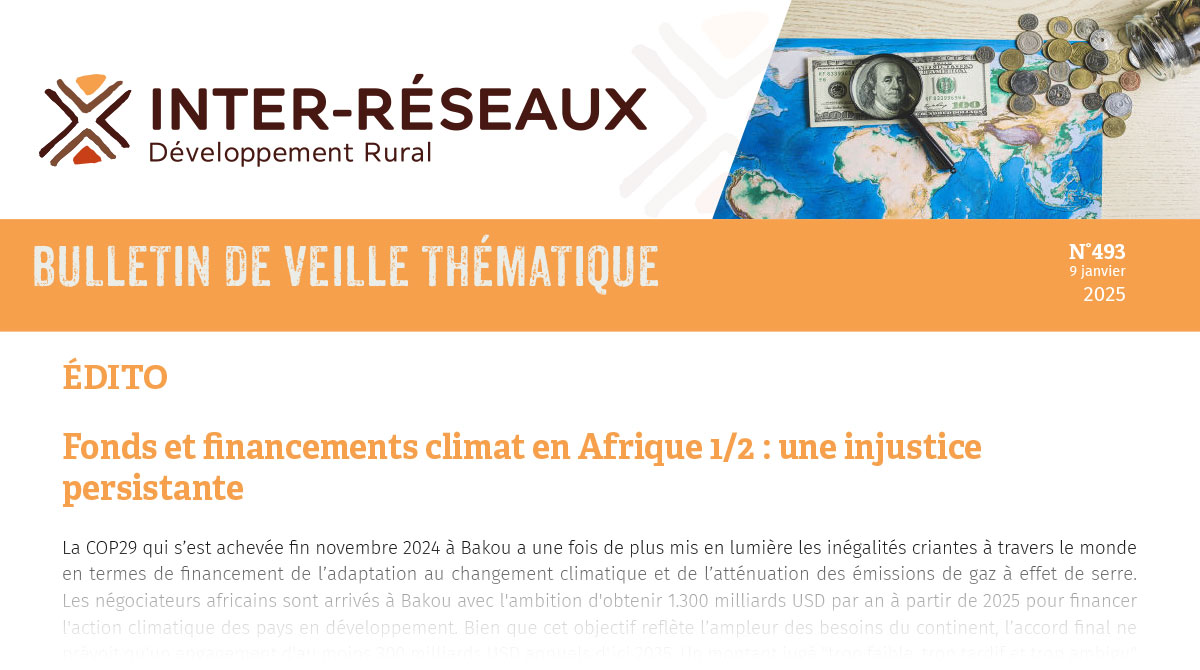Thematic monitoring bulletin no. 493: Climate funds and financing in Africa 1/2: a persistent injustice

➡️ Access the document
Thematic BDV 493 – Climate funds and financing in Africa 1/2: a persistent injustice
COP29, which ended at the end of November 2024 in Baku, has once again highlighted the glaring inequalities across the world in terms of financing for climate change adaptation and greenhouse gas mitigation. African negotiators arrived in Baku with the ambition of securing USD 1.3 trillion per year from 2025 to finance climate action in developing countries. While this objective reflects the scale of the continent's needs, the final agreement only provides for a commitment of at least USD 300 billion annually by 2035. This amount was deemed "too little, too late and too ambiguous" by the African group, which widely criticized the persistent gap between promises and reality of climate finance, particularly for Africa.
This situation illustrates a double injustice.On the one hand, Africa, which is responsible for only 4% of global greenhouse gas emissions, is one of the areas most vulnerable to the effects of climate change. On the other hand, the continent struggles to access the liquidity needed to finance both its development and its climate ambitions. Indeed, Africa receives only a fraction of climate funds, barely USD 30 billion in 2020, and a significant portion of this financing is directed towards debt instruments rather than grants, thus increasing the financial pressure on recipient countries.
Produced in partnership with Inter-Réseaux, this thematic monitoring bulletin from the FARM Foundation shares keys to understanding the functioning and current state of climate funds and financing, particularly in Africa. It is designed in two parts, initially distributed ahead of our 2025 International Conference.
The first part focuses on the inequity in access to these funds: between 2016 and 2021, only 17% of the funds were intended for least developed countries, with small family farms receiving only 0.3% of climate finance. The diversity of financing mechanisms can create a lack of coordination, and the lack of a standardized definition of “climate finance” leads to inconsistencies in the accounting of financial flows. These mechanisms also raise the question of North/South responsibilities and environmental debt.
The second part offers illuminating resources on the levers to access this financing while presenting innovative initiatives at local and national level to address the climate challenge.
These resources show that the obstacles are as much institutional as structural. It is therefore time to fundamentally rethink climate financing mechanisms. COP30, scheduled for November 2025 in Brazil, has the main objective of revising and increasing climate finance commitments.It remains to be seen whether this will also involve an overhaul of the allocation criteria and the terms of access to this funding.
The FARM Foundation 2025 International Conference, organized on Tuesday, January 28, 2025 at the Cité internationale universitaire de Paris and accessible online, was devoted to impact measurement in agricultural investments, in continuation of the 2024 work on financing the transformation of agriculture.
The summaries of this edition are now available on the FARM Foundation website: https://fondation-farm.org/la-mesure-dimpact-des-financements-agricoles-casse-tete-ou-amorce-dun-cercle-vertueux/
